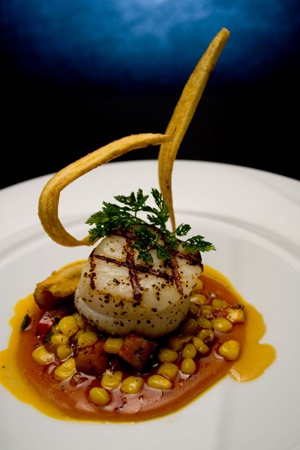 |
|

| Aged to Perfection |
| Pop Art |
| Bottling Up Success |
| Edible Art |
Edible Art: Wisconsin Chefs Create Masterpieces in the Kitchen |
||||||
| Continued... | ||||||
To create a dish, many chefs describe visualizing it and then using their mental picture to apply the techniques to create a taste. Shinji Muramoto, chef and owner of Restaurant Muramoto and Sushi Muramoto in Madison, compares the mental preparation of a dish's taste to painting a picture. “Sometimes I explain to my cooks that creating a taste is just like mixing different colors,” Muramoto said. “You need to know what kind of color you want in your head. And like blue plus yellow makes green, taste is the same. First, you need to know what kind of taste you’re looking for, then you need to pick what else you need to use and how to mix them up.” The Art of Presentation: Eye Appeal
“I think food has to look attractive to the eye because when it sits down in front of [people], that’s the first thing they see,” said Charles Lazzareschi, executive chef at the Madison Concourse Hotel. “Layering flavors, layering foods. You have textures. Crispy, crunchy, soft. It’s all going together in the same plate.” Just as artists who create paintings or drawings want to catch a viewer’s eye, chefs use techniques to present food in a visually appealing way to diners, Lazzareschi said. Placing an odd number of different foods on a plate is one such technique that makes food stand out on the plate. Wright added chefs use a diametrical art philosophy to present textures of food. A spicy dish could be paired with a cool yogurt atop. Or the crunchy outer texture of a crème brule dessert gives way to a creamy, smooth filling. In his presentation, Guevara focuses on how the taste and color of ingredients work together, using contrasting colors, shapes and flavors of ingredients to make his mental visualization of the entire dish a vibrant reality. For example, he describes a dish using halibut. “The contrast of the green, white and yellow fish and some South-American peppers,” he said. “It's art.” For some chefs, a dish is like a rainbow on a plate. Guevara prefers to pool sauces on the bottom of the plate, then layer an array of colorful vegetables before placing the fish or meat on top. The diversity of colors on a dish is what brings the dish to life and allows for innovation and creativity that makes cooking an art form, Lazzareschi added. “Colors, you can look at a plate and say ‘what does that need? What does that need?’” he said. “Well, it needs some red, but I don’t want to use tomatoes, I’m sick of tomatoes. What else do we got?” Although it’s a complex combination of colors, textures, flavors and placement that make food visually appealing, diners must be able to evaluate the plate in front of them and understand how they should go about eating it. “It’s got to be practical also,” Lazzareschi said. “When you look at it, is it, ‘what the hell is this guy thinking?’ Or, ‘this is beautiful.’” Wisconsin Dining: Experience the Art |
||||||
About Us | Contact Us | Business Partners | Archives | Sitemap
Copyright 2007 Curb Magazine
